- You are here:
- Home »
- Hazelwood
Tag Archives for " Hazelwood "
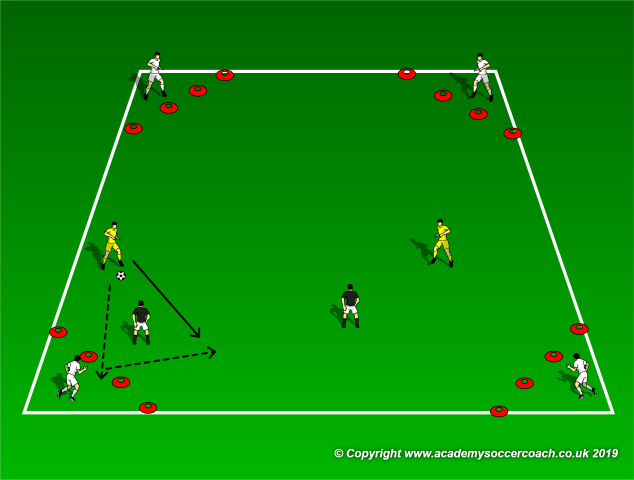
Corner Combination Play
By Anthony Hazelwood
The following activity has an 18 x 18 yd. box area where players will play 2 vs. 2. An additional triangle on each side is placed three yards from each side. Pairs will play for 90 seconds and then switch/rotate with corner players. This will achieve adaptations in the anaerobic energy system and produce soccer specific muscle tension actions.
When preparing the activity, if needed, concentration and difficulty levels may be increased by having players execute something extra unique by setting more restrictions. Every activity may be modified, and it is up to the coach to be creative. However, it is important to respect the parameters of the exercise time, the rest, the types of actions used and the weekly periodization of the activity.
Additionally, it is beneficial to train a soccer team and its players with all the elements of the game is present in the session. By doing so, it will promote soccer specific adaptations to the player’s body, mind, and emotional triad. Ultimately, these adjustments will enhance their real-time game performances on a physical, emotional, conscious, and subconscious mental level.
Area Size: 18 d. x 18 yd.
Total Activity Time: 12 minutes.
Sets: 1.
Number of Repetitions: 8
Activity Repetition Time: 90 seconds
Recovery Interval Time between reps: Quick transition between inside and corner players.
Intensity: High.
Objectives:
• Tactical: Improve combinations plays.
• Fitness: Maintain high intense corporal actions.
• Technique: Proper fitness and off/on the ball execution/techniques.
• Mental-Emotional: Players fully engaged and concentration is high.
• Concentration Level: High.
Setup:
• Create an 18 x 18-yard grid with triangle at each corner.
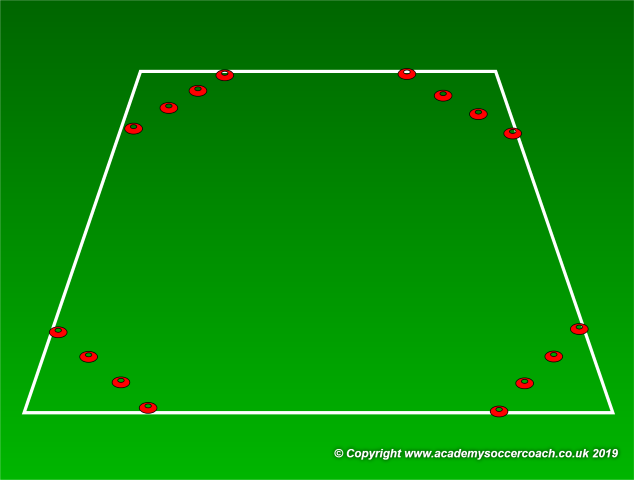
• Put players into players (Two pairs in the inside) and place one corner player in each zone.
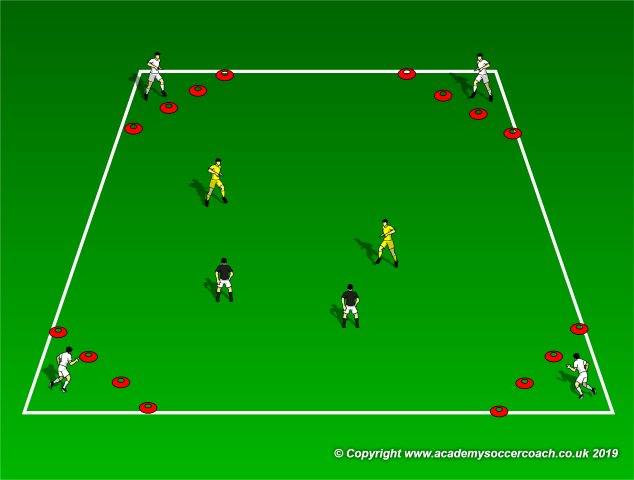
• Pairs play for 90 seconds and try to combine with each other or with a corner player for points.

• Third man combination.
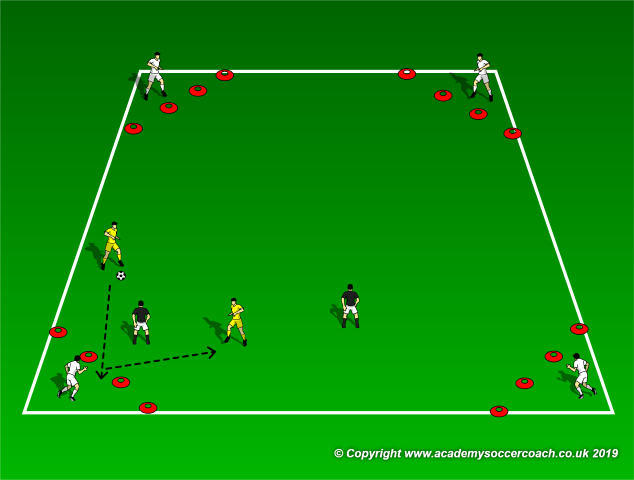
• After 90 seconds players quickly rotate and commence the next 90 seconds.
Activity Point System:
• 1 point for corner play wall pass.
• 2 points for Third man combination or inside pair wall pass.
• One touch everywhere.
• Progression: when a point is scored corner players rotate to the next corner quickly.
Coaching Points:
• Support.
• Verbal and nonverbal communication.
• Dribble to opponent use teammate for combo play.
By Anthony Hazelwood
Coach Anthony is a USSF “A” licensed coach with an M.S. in Sports Training and Nutrition and a B.S. in Physical Education. Currently, he is an Assistant and Sports Performance coach with the Miami FC. He has previous European youth academy coaching experience as a soccer fitness and strength/conditioning assistant coach with Levante U.D. and Getafe SAD in Valencia and Madrid, Spain.
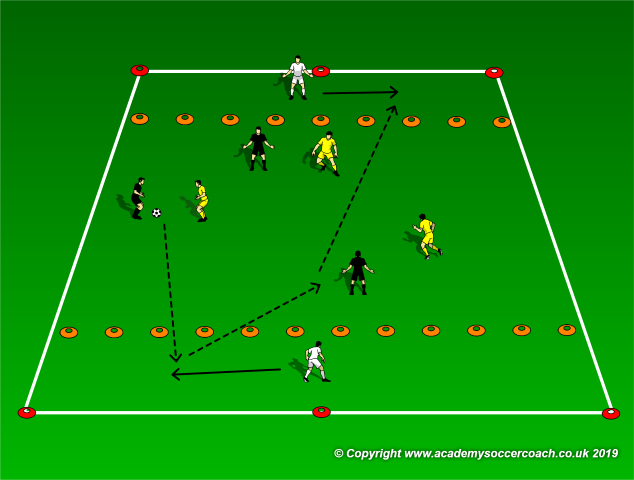
3v3 Change the Point of Attack for Anaerobic Capacity
By Anthony Hazelwood
The following activity has two teams of three playing a 3 vs. 3 possession game including two bumper neutral players. Team play 3 vs. 3 in a middle zone and keep possession with a bumper player located at each side of the grid. The idea is for the team in possession to keep the ball by using the width to break out of pressure. The specific fitness target is intermittent endurance while adapting the player’s anaerobic capacity in a small sided group format.
When preparing the practice, if needed, concentration and difficulty levels may be increased by having players execute something extra unique by setting more restrictions. Every activity may be modified, and it is up to the coach to be creative. However, it is important to respect the parameters of the exercise time, the rest, the types of actions used and the weekly periodization of the activity.
Additionally, it is beneficial to train a soccer team and its players with all the elements of the game being present in the session. By doing so, it will promote soccer specific adaptations to the player’s body, mind, and emotional triad. Ultimately, these adjustments will enhance their real-time game performances on a physical, emotional, conscious, and subconscious mental level.
Area Size: 20 yds. L x 30 yds. W and an extra 5 yd. zone on each side.
Total Activity Time: 18 minutes.
Sets: 1 set.
Activity Repetitions: 6 repetitions.
Time of Activity Repetition: 2 minutes.
Recovery Time: 1 minute.
Intensity: High.
Objectives:
• Tactical: Switching the point of attack, possession, support.
• Fitness: Muscle Tension activity with anaerobic capacity training adaptations.
• Technique: Proper fitness and off/on the ball execution/techniques.
• Mental-Emotional: Players fully engaged and concentration is high.
• Concentration Level: High.
Setup:
• Mark out a 20 yds. L x 30 yds. W and an extra 5 yd. zone on each side.

• Two teams of three in the middle zone and add a bumper player on each side of the grid.

• Play begins with a team trying to combine and make 7 seven points to score a goal.

• Two points are awarded if the ball circulates from side to middle player to side player.
• Progression: Make 5 passes and then cross over line (make it directional).
Coaching Points:
• High competitive mindset.
• Verbal and Non-Verbal Communication off and on the ball.
• Support
• Ball Circulation
• Body angles
By Anthony Hazelwood
Coach Anthony is a USSF “A” licensed coach with an M.S. in Sports Training and Nutrition and a B.S. in Physical Education. Currently, he is an Assistant and Sports Performance coach with the Miami FC. He has previous European youth academy coaching experience as a soccer fitness and strength/conditioning assistant coach with Levante U.D. and Getafe SAD in Valencia and Madrid, Spain.
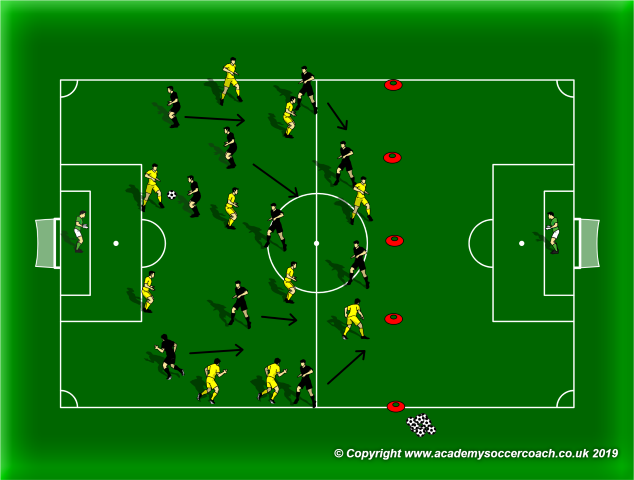
Team Defensive Transition – Aerobic Capacity – Match Endurance
By Anthony Hazelwood
The following activity educates a team to defensively transition effectively and stop the opponent from breaking into their attacking third. The specific fitness target is match endurance while adapting the player’s aerobic capacity in an extended small-sided format.
When preparing the activity, if needed, concentration and difficulty levels may be increased by having players execute something extra unique by setting more restrictions. Every activity may be modified, and it is up to the coach to be creative. However, it is important to respect the parameters of the exercise time, the rest, the types of actions used and the weekly periodization of the activity.
Additionally, it is beneficial to train a soccer team and its players with all the elements of the game being present in the session. By doing so, it will promote soccer specific adaptations to the player’s body, mind and emotional triad. Ultimately, these adjustments will enhance their real-time game performances on a physical, emotional, conscious, and subconscious mental level.
Area Size: Full Pitch with a 65 yds. Length X Full Width Area.
Total Activity Time: 20 Minutes.
Sets: 1.
Intervals: 2.
Activity Time: 9 minutes.
Recovery Interval Time between Sets: 2 minutes.
Intensity: High.
Objectives:
• Tactical: Transitional Defensive practice – avoid opponents pass into defensive third.
• Fitness: Aerobic Capacity – Match Endurance.
• Technique: Proper fitness and off/on the ball execution/techniques.
• Mental-Emotional: Players fully engaged and concentration is high.
• Concentration Level: High.
Setup:
• Full Pitch with 65 yd. L x Full Width initial playing area.
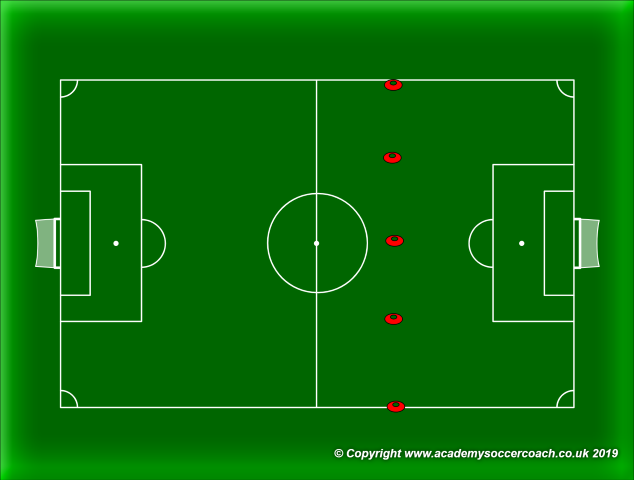
• Black team (1-4-3-3) looks to score in 65 x full width pitch.
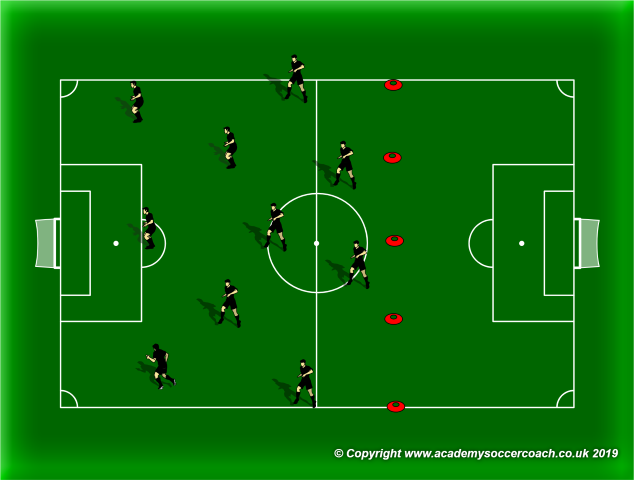
• Yellow team (1-4-4-2) looks to regain possession to go to goal and score.
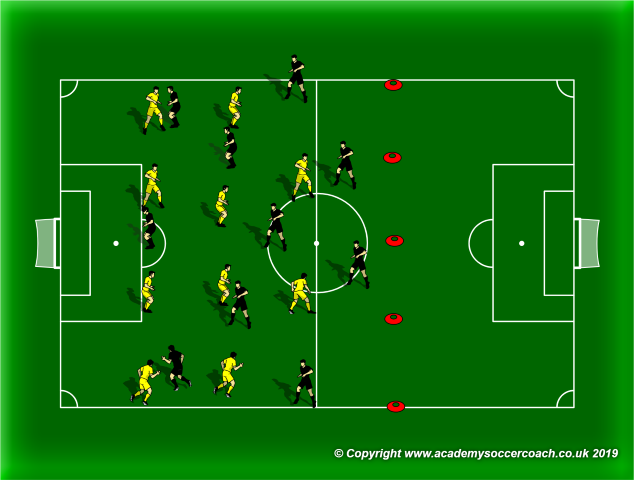
• Ball always starts with Black team in the initial playing zone. Throw-ins and corners are always in play in playing area.
• The Black team work to score goals and if they score, they keep ball that is given at the line of cones.
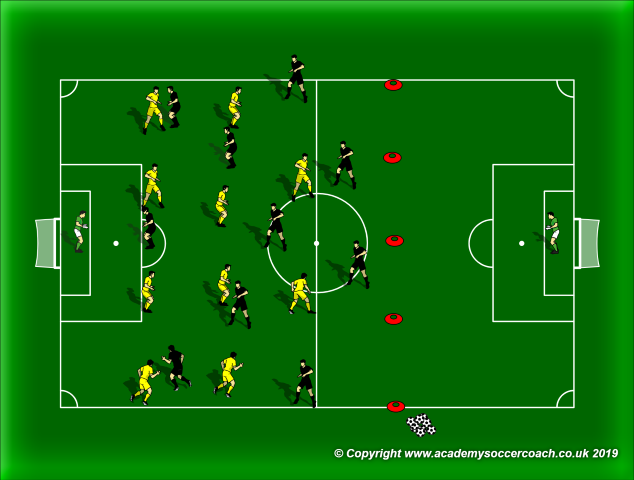
• If the yellow team regains possession of the ball during free play, the black team must perform a high intense pressure to retrieve the ball.

• If the yellow team passes the red line and break into their attacking third and score or the ball goes out of bounds, the play restarts and black team receive ball at red line.
• The objective is for Black team to defensively transition effectively and stop the opponent from breaking into their attacking third.
Coaching Points:
• Defending tactics is up to the coach, but the work rate to perform this activity when transitioning to defense on a physical level needs to be shows.
• This activity will develop a team’s match endurance potential specifically targeting high pressure defensive attributes on transitional defensive moments.
By Anthony Hazelwood
Coach Anthony is a USSF “A” licensed coach with an M.S. in Sports Training and Nutrition and a B.S. in Physical Education. Currently, he is an Assistant and Sports Performance coach with the Miami FC. He has previous European youth academy coaching experience as a soccer fitness and strength/conditioning assistant coach with Levante U.D. and Getafe SAD in Valencia and Madrid, Spain.
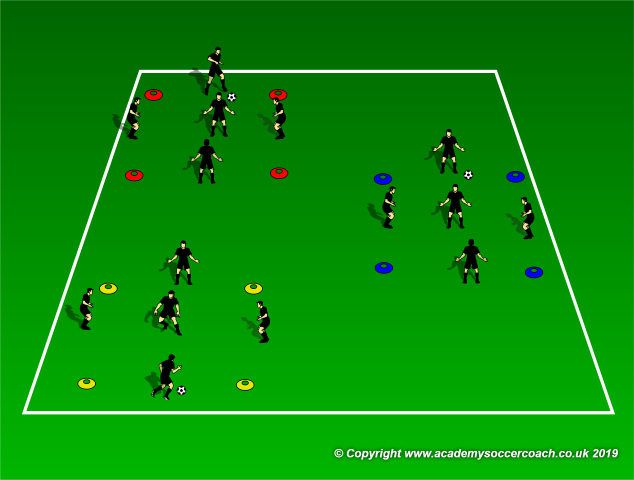
Sprinting Rondos
By Anthony Hazelwood
The following activity has three 10 yd. x 10 yd. rondo areas at 15 yards away from each other. Each rondo grid will have 5 players and they will play a 4 vs. 1 activity. When playing, the defender in the middle just needs to touch the ball to rotate with another player. At the coach’s signal, the players will print clockwise to the next rondo grid located 15 yards away. The last player to reach the grid will start in the middle. These types of activities are great for athletic speed development. Rest times should be extensive as to completely recover for the next signal. It’s important that each sprint is done maximally — proper rest between sprints is important. 30 seconds rondo play before each sprint should be performed as this activity helps adapt the creatine phosphate system.
When preparing the activity, if needed, concentration and difficulty levels may be increased by having players execute something extra unique by setting more restrictions. Every activity may be modified, and it is up to the coach to be creative. However, it is important to respect the parameters of the exercise time, the rest, the types of actions used and the weekly periodization of the activity.
Additionally, it is beneficial to train a soccer team and its players with all the elements of the game is present in the session. By doing so, it will promote soccer specific adaptations to the player’s body, mind, and emotional triad. Ultimately, these adjustments will enhance their real-time game performances on a physical, emotional, conscious, and subconscious mental level.
Area Size: Three 10 yd. x 10 yd. rondos
Total Activity Time: 10 minutes.
Sets: 2.
Number of Repetitions: 10
Recovery Interval Time between reps: 30 seconds.
Intensity: High.
Objectives:
• Tactical: Attacking Diamond shape in rondo – Proper supporting positions.
• Fitness: Maintain high intense corporal actions.
• Technique: Proper fitness and off/on the ball execution/techniques.
• Mental-Emotional: Players fully engaged and concentration is high.
• Concentration Level: High.
Setup:
• Create Three 10 yd. x 10 yd. rondo grids.
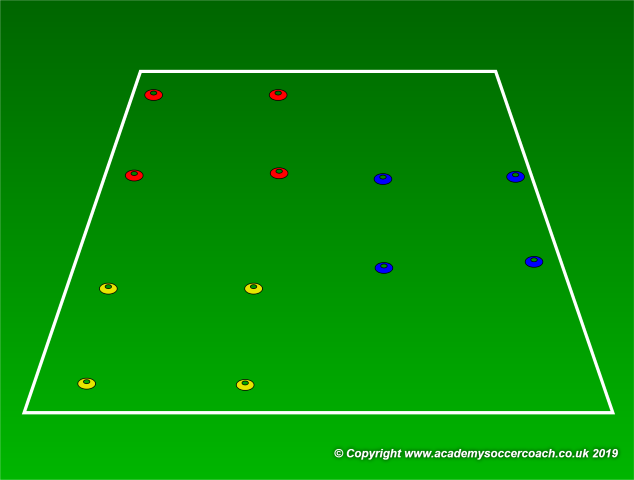
• Place five players in each grid and make it a 4 vs. 1 scenario.

• Begin playing a 4 vs. 1 for 30 seconds.
• On the coach’s whistle, players sprint clockwise to the next rondo grid.
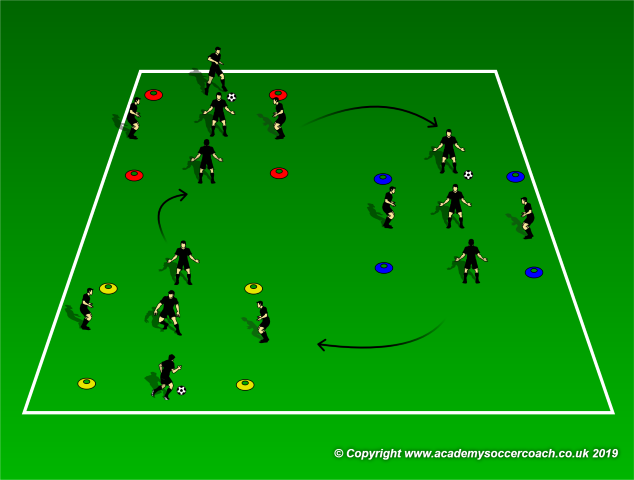
• To add, if the coach whistles twice, the players will sprint counter clockwise.
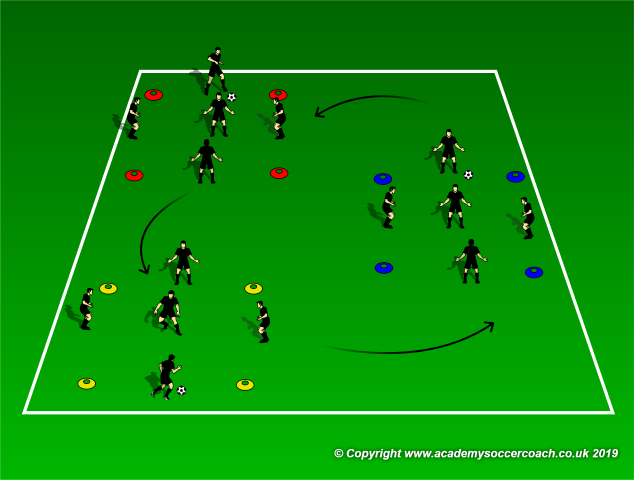
Activity Progression:
• One touch play.
• One – Two touch play.
Coaching Points:
• High intensity.
• Proper technique and Proper Exercise Movement.
By Anthony Hazelwood
Coach Anthony is a USSF “A” licensed coach with an M.S. in Sports Training and Nutrition and a B.S. in Physical Education. Currently, he is an Assistant and Sports Performance coach with the Miami FC. He has previous European youth academy coaching experience as a soccer fitness and strength/conditioning assistant coach with Levante U.D. and Getafe SAD in Valencia and Madrid, Spain.
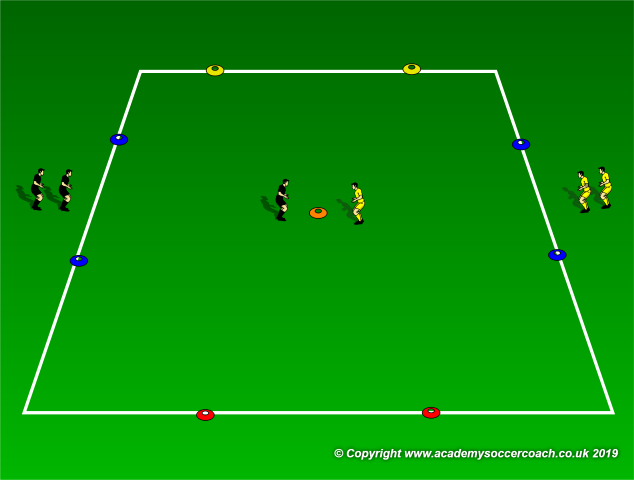
1v1 Speed Reaction
By Anthony Hazelwood
The following activity has a 15 yd. x 15 yd. playing area where two teams split up and form a single file line located at the sides of the grid. On the coach’s signal, the first player from each line will sprint to the cone located at the middle of the grid. Once there, the coach will call out a color. Once the color is called, players must react and sprint through the corresponding colored gates. First player to reach and pass the gates wins. These types of activities are great for athletic speed development. Rest times should be extensive as to completely recover for the next round. It’s important that each sprint is done maximally — proper rest between sprints is important.
When preparing the activity, if needed, concentration and difficulty levels may be increased by having players execute something extra unique by setting more restrictions. Every activity may be modified, and it is up to the coach to be creative. However, it is important to respect the parameters of the exercise time, the rest, the types of actions used and the weekly periodization of the activity.
Additionally, it is beneficial to train a soccer team and its players with all the elements of the game is present in the session. By doing so, it will promote soccer specific adaptations to the player’s body, mind, and emotional triad. Ultimately, these adjustments will enhance their real-time game performances on a physical, emotional, conscious, and subconscious mental level.
Area Size: 15 yd. x 15 yd.
Total Activity Time: 10 minutes.
Sets: 1.
Number of Repetitions: 10
Recovery Interval Time between reps: 1:8.
Intensity: High.
Objectives:
• Tactical: Decision Making to cone gates.
• Fitness: Maintain high intense corporal actions.
• Technique: Proper fitness and off/on the ball execution/techniques.
• Mental-Emotional: Players fully engaged and concentration is high.
• Concentration Level: High.
Setup:
• Create a 15 x 15-yard grid with pairs of cones on each sided.
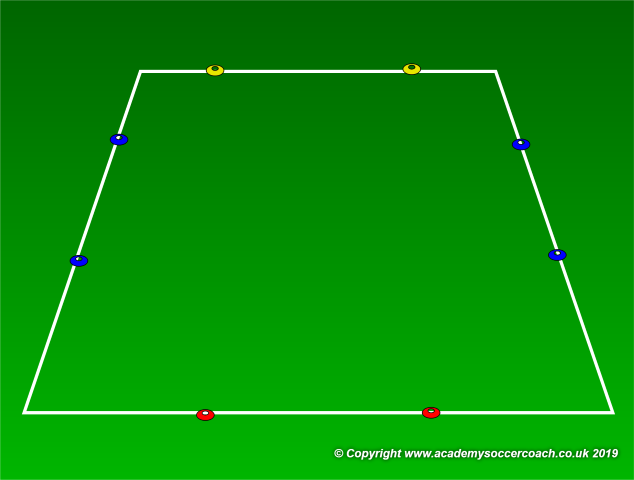
• Place a cone in the middle of grid — Create two teams of eight team and place them in a single file line at sides (blue cones).
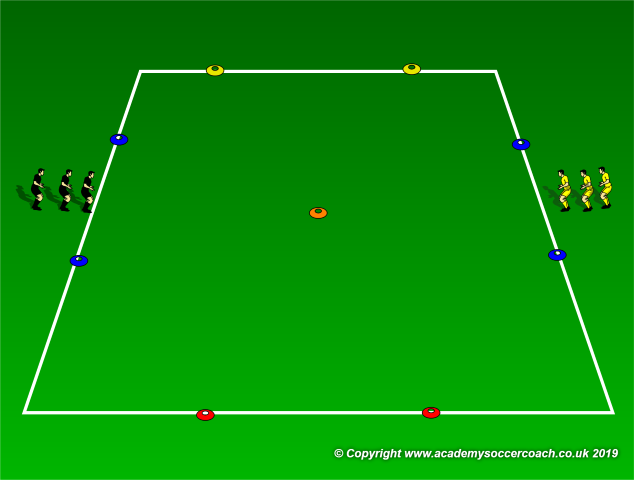
• On coach’s whistle, first player from each line will sprint to the middle cone.
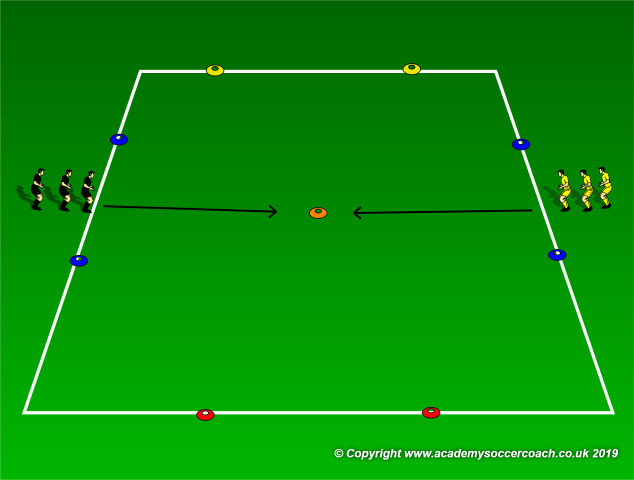
• Once there, players will be on toes and coach will yell out a color.
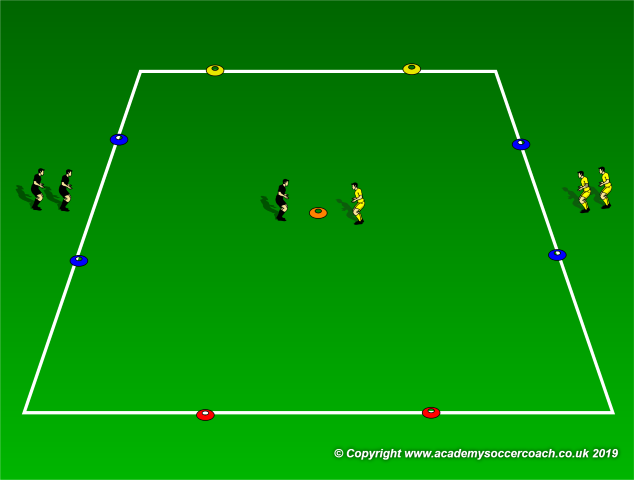
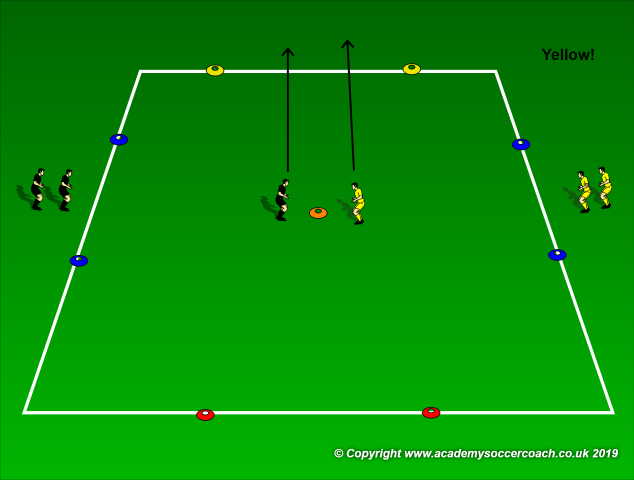
• Once completed, players return to their lines and wait their turns.
Activity Progression:
• Play with a soccer ball.
• Blue coned gates are in play.
Coaching Points:
• High intensity.
• Proper technique and Proper Exercise Movement.
By Anthony Hazelwood
Coach Anthony is a USSF “A” licensed coach with an M.S. in Sports Training and Nutrition and a B.S. in Physical Education. Currently, he is an Assistant and Sports Performance coach with the Miami FC. He has previous European youth academy coaching experience as a soccer fitness and strength/conditioning assistant coach with Levante U.D. and Getafe SAD in Valencia and Madrid, Spain.
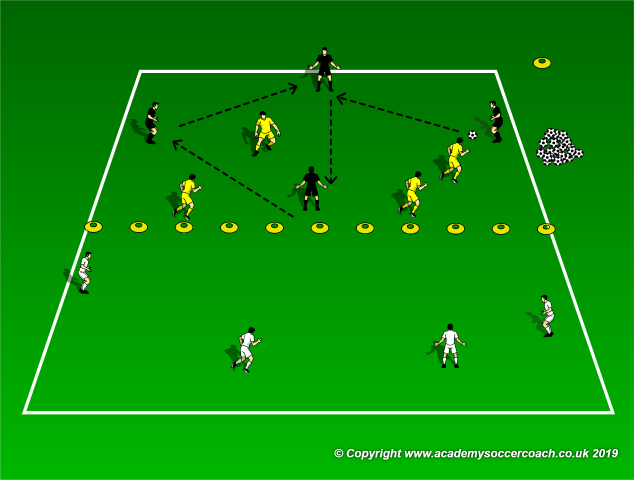
Training the Center Midfielder For Anaerobic Capacity
By Anthony Hazelwood
The following activity has a playing area where a Center Midfielder (CM) will play against three defenders and 4 teammates positioned on each sideline. The CM will be working to adapt their anaerobic capacity through phases of intermittent endurance by being in constant movement for a minute at a time. The grid will be 18 x 18 and may be modified to the coach’s convenience. To start, a CM will be located on the inside of the grid along with four teammates located on each sideline. Three defenders will then be added. Once inside, the CM and teammates will keep possession by circulating the ball and combining. When the defending team retains possession of the ball it is restarted with the attacking team as quick as possible. Once the 1-minute repetition is complete, switch the CM player with another midfield player.
When preparing the activity, if needed, concentration and difficulty levels may be increased by having players execute something extra unique by setting more restrictions. Every activity may be modified, and it is up to the coach to be creative. However, it is important to respect the parameters of the exercise time, the rest, the types of actions used and the weekly periodization of the activity.
Additionally, it is beneficial to train a soccer team and its players with all the elements of the game is present in the session. By doing so, it will promote soccer specific adaptations to the player’s body, mind, and emotional triad. Ultimately, these adjustments will enhance their real-time game performances on a physical, emotional, conscious, and subconscious mental level.
Area Size: 18 d. x 18 yd.
Total Activity Time: 12 minutes.
Sets: 1.
Number of Repetitions: 10
Activity Repetition Time: 1-minute seconds
Recovery Interval Time between reps: 10 seconds.
Intensity: High.
Objectives:
• Tactical: Movement on and off the ball of the CM. Attacking shape and circulation.
• Fitness: Maintain high intense corporal actions.
• Technique: Proper fitness and off/on the ball execution/techniques.
• Mental-Emotional: Players fully engaged and concentration is high.
• Concentration Level: High.
Setup:
• Create an 18 x 18-yard grid.
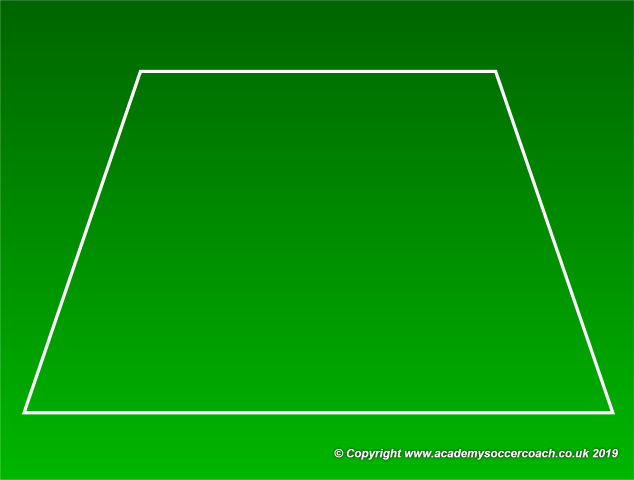
• Create a team five and one team of three.
• From the team of five, locate four players on each sideline and one CM in the middle.
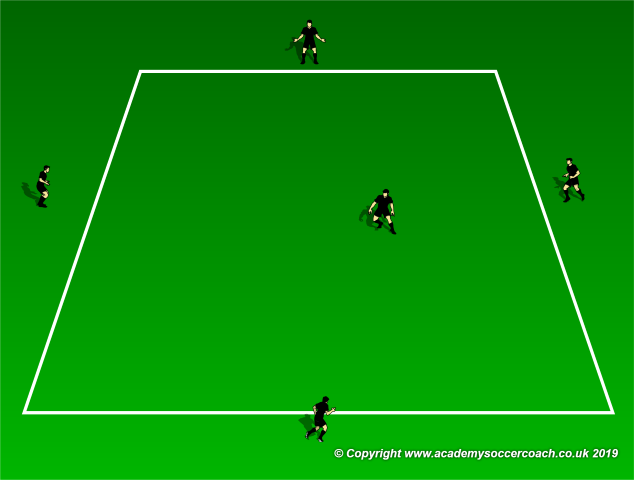
• Team of three, place three defenders in the middle.
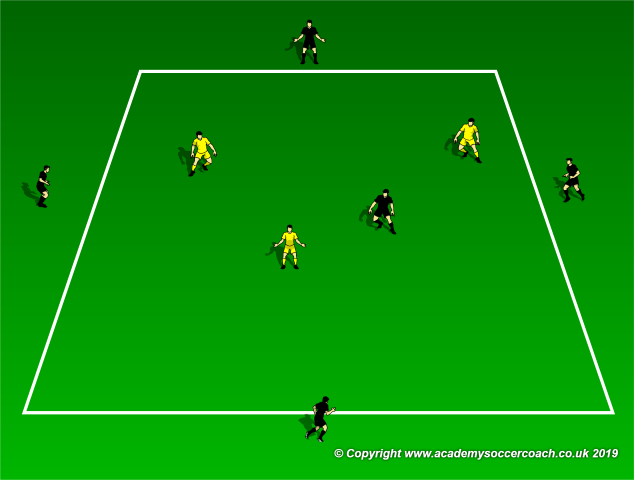
• On whistle, give ball to the attacking team. The team in possession plays a 5 vs. 3 with sideline restrictions.
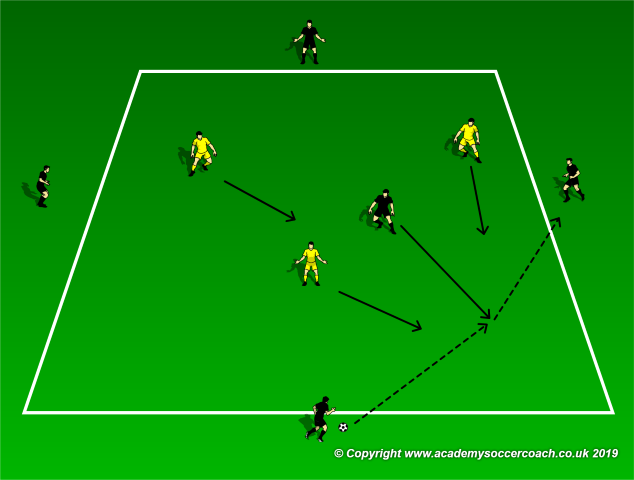
• On a turnover, the defending gives possession back.
• This will last for 1 minute. 10 seconds in between reps and quickly begin again.
Activity Progression:
• Play a one touch with the outside player and two touch on the inside restriction.
• One touch everywhere.
Coaching Points:
• CM movement on and off the ball.
• Supporting player on ball with proper angles.
• Aggressive defending behaviors.
• Pressure and cover defending principles.
• Keep track of time, 30 second on – 30-second rest.
• High intensity.
• Proper technique and Proper Exercise Movement.
By Anthony Hazelwood
Coach Anthony is a USSF “A” licensed coach with an M.S. in Sports Training and Nutrition and a B.S. in Physical Education. Currently, he is an Assistant and Sports Performance coach with the Miami FC. He has previous European youth academy coaching experience as a soccer fitness and strength/conditioning assistant coach with Levante U.D. and Getafe SAD in Valencia and Madrid, Spain.
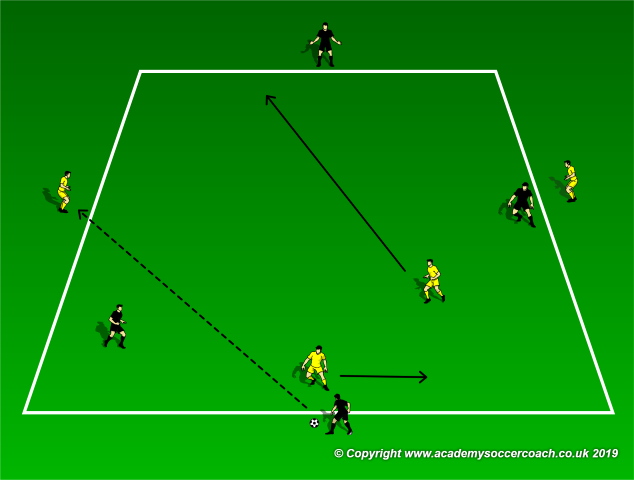
Speed Development With Shadow Play 3vGK
By Anthony Hazelwood
The following activity has three lines of players working on patterns of play. Players will be working to adapt their speed production within the creatine phosphate system. Play will begin from the attacking middle third area. To begin, three lines of players will work on different patterns of play to goal. The important factor here is the speed of play the activity is performed in. Make sure sprints are maximal.
When preparing the activity, if needed, concentration and difficulty levels may be increased by having players execute something extra unique by setting more restrictions. Every activity may be modified, and it is up to the coach to be creative. However, it is important to respect the parameters of the exercise time, the rest, the types of actions used and the weekly periodization of the activity.
Additionally, it is beneficial to train a soccer team and its players with all the elements of the game is present in the session. By doing so, it will promote soccer specific adaptations to the player’s body, mind, and emotional triad. Ultimately, these adjustments will enhance their real-time game performances on a physical, emotional, conscious, and subconscious mental level.
Area Size: Half a field.
Total Activity Time: 15 minutes.
Sets: 3
Number of Repetitions: 9 (three reps on each cone.)
Intensity: High.
Objectives:
• Tactical: Patterns of play.
• Fitness: Maintain high intense corporal actions.
• Technique: Proper fitness and off/on the ball execution/techniques.
• Mental-Emotional: Players fully engaged and concentration is high.
• Concentration Level: High.
Setup:
• Put three cones at the attacking third portion of the field.
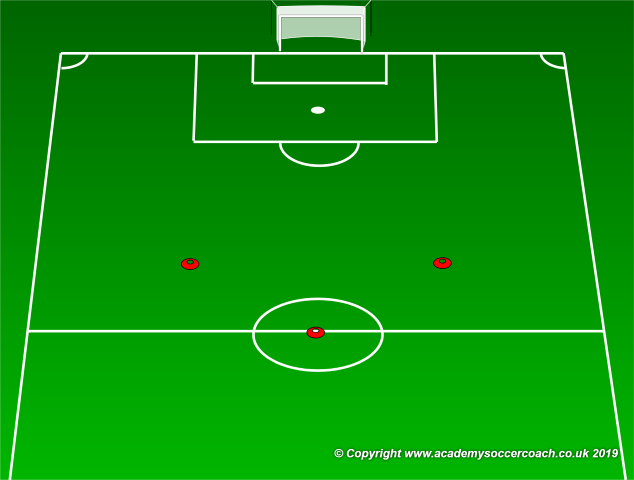
• Put players on cones.
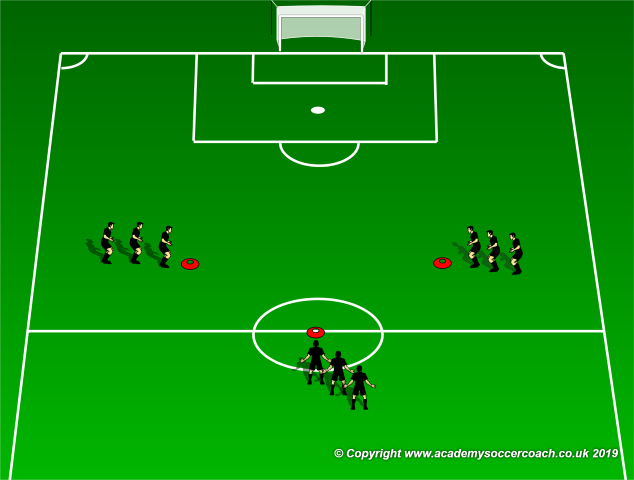
• Perform Pattern #1: Repeat on Both Sides.
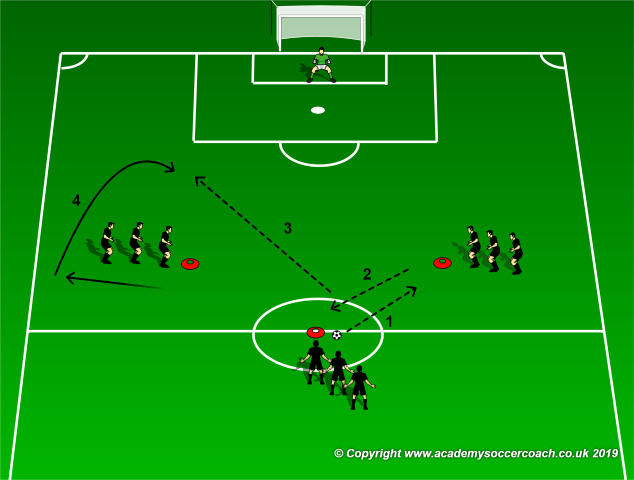
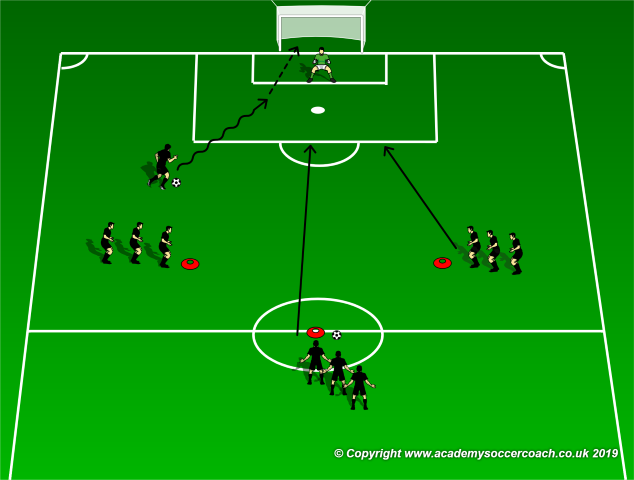
• Perform Pattern #2: Repeat on Both Sides
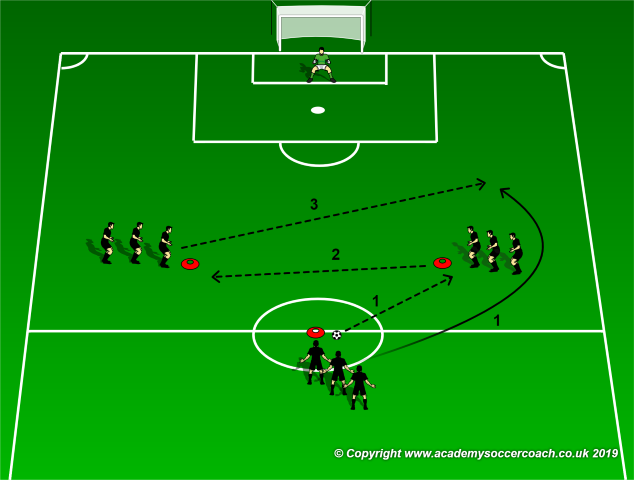
6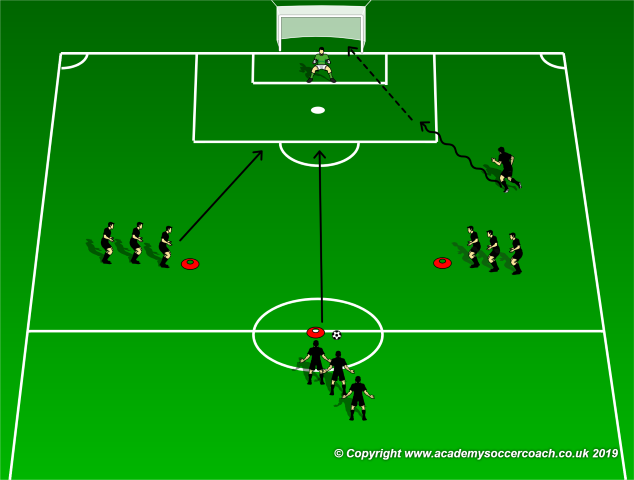
Coaching Points:
• Technical and Tactical executions at speed.
• Timing of runs.
• Keep lines at proper work to rest ratio. Players need more rest to recover to perform the action maximally again.
By Anthony Hazelwood
Coach Anthony is a USSF “A” licensed coach with an M.S. in Sports Training and Nutrition and a B.S. in Physical Education. Currently, he is an Assistant and Sports Performance coach with the Miami FC. He has previous European youth academy coaching experience as a soccer fitness and strength/conditioning assistant coach with Levante U.D. and Getafe SAD in Valencia and Madrid, Spain.

Anaerobic Capacity Three teams 4v4 Possession Game
By Anthony Hazelwood
The following activity has three teams of four players playing a possession game. Players will be working to adapt their anaerobic capacity through intermittent endurance. A 30-length x 50-yard width split into a half will be built. To begin, two teams will be located on one side of the activity grid as the offensive teams. The other team will be playing as the defensive team and located on one side of the grid.
The objective of the activity is to maintain possession and to switch play when the passing restriction has been broken. Once this is done the defending team moves to the other side of the grid to defend the other team. If the defending team wins the ball, then they become the attacking team. The team that lost the ball will turn into the defending group.
When preparing the activity, if needed, concentration and difficulty levels may be increased by having players execute something extra unique by setting more restrictions. Every activity may be modified, and it is up to the coach to be creative. However, it is important to respect the parameters of the exercise time, the rest, the types of actions used and the weekly periodization of the activity.
Additionally, it is beneficial to train a soccer team and its players with all the elements of the game is present in the session. By doing so, it will promote soccer specific adaptations to the player’s body, mind, and emotional triad. Ultimately, these adjustments will enhance their real-time game performances on a physical, emotional, conscious, and subconscious mental level.
Area Size: 30 yds. length x 50 yds. width.
Total Activity Time: 16 minutes.
Sets: 1.
Number of Repetitions: 5
Activity Repetition Time: 2 minutes.
Recovery Interval Time: 1 minute.
Intensity: High.
Objectives:
• Tactical: Quick supporting actions to maintain possession to switch play.
• Fitness: Maintain high intense corporal actions.
• Technique: Proper fitness and off/on the ball execution/techniques.
• Mental-Emotional: Players fully engaged and concentration is high.
• Concentration Level: High.
Setup:
• Create a grid that is 30 yds length and 50 yds. width split down the middle.
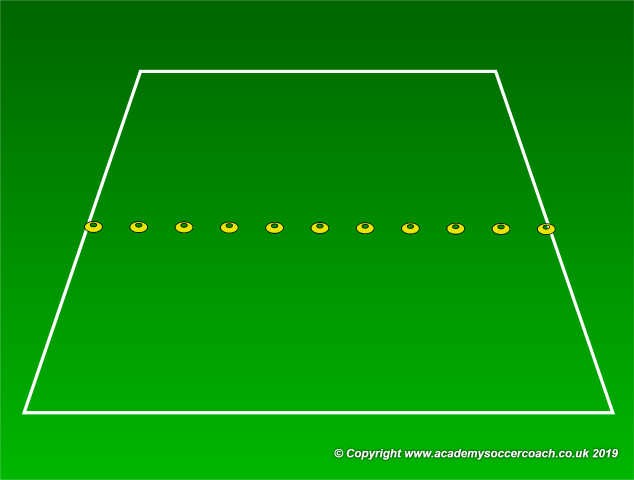
• Two teams of four players located on each side of the grid.
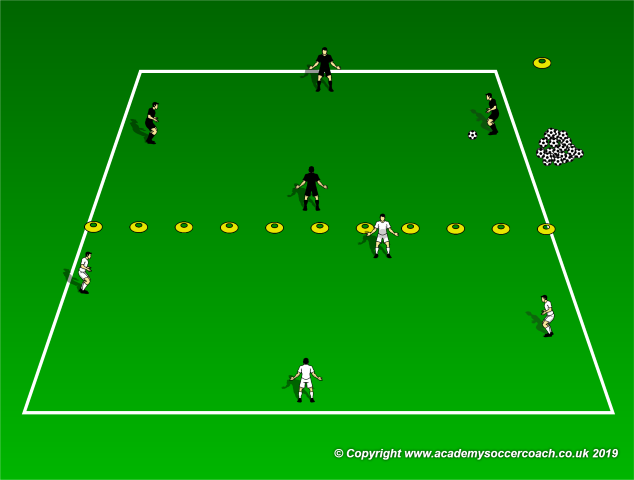
• One defensive team ready to commence vs. another team.
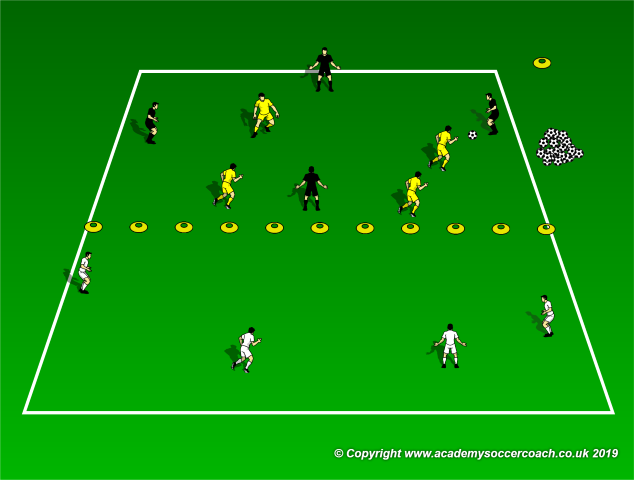
• At the whistle, the run of play will commence.
• The team in attack will have to make four passes before the ball may be passed to the other team.
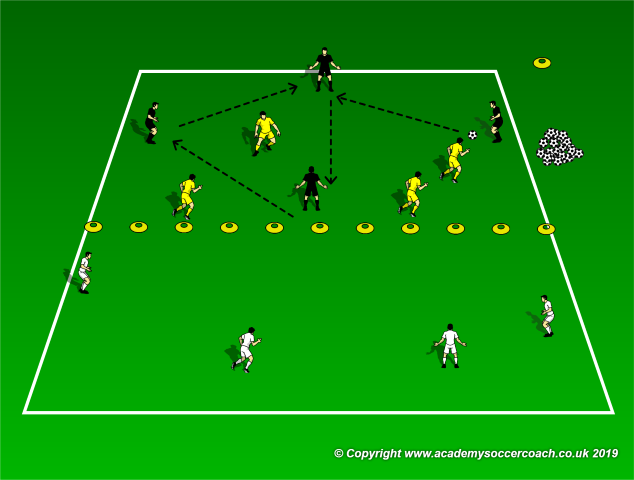
• Once this is done, the defending team moves quickly to the other half and defends.
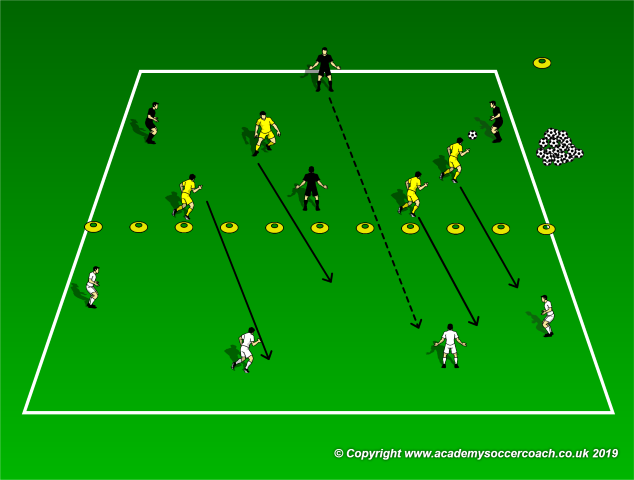
• If the team successfully takes the ball away, then they pass to the other grid and stay as the team in offense.
Coaching Points:
• Attentiveness.
• Keep track of time, 2 minutes play – 1 minute rest.
• High intensity.
• This session is continuous for two minutes, make sure to keep moving.
• Proper technique and Proper Exercise Movement.
• Proper exercise movements when attacking players are idle.
• If progressions are needed: After every pass a five yard sprint must be completed – Team waiting in the attack needs to perform some kind of upper body exercise until the ball is switched.
By Anthony Hazelwood
Coach Anthony is a USSF “A” licensed coach with an M.S. in Sports Training and Nutrition and a B.S. in Physical Education. Currently, he is an Assistant and Sports Performance coach with the Miami FC. He has previous European youth academy coaching experience as a soccer fitness and strength/conditioning assistant coach with Levante U.D. and Getafe SAD in Valencia and Madrid, Spain.
